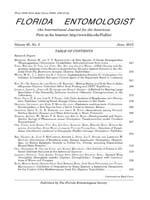Trehala are unusual insect pupal chambers that are sweet and have been used as human food (Pierce 1915). Trehala are constructed on the outside of stems by larvae in the genus Larinus Dejean, 1821 (Coleoptera: Curculionidae: Lixinae). New data on 4 trehala constructing species of Larinus were recently presented by Gültekin (2008). Trehala-like capsule constructions have also been observed in several genera of Cleonini, including Conorhynchus Motschulsky, 1860, Trichocleonus Motschulsky, 1860, Scaphomorphus Motschulsky, 1860 and Pachycerus Schoenherr, 1823 (Volovnik 2010), and the Lixini genus Hypolixus Desbrochers, 1898 (Nikulina 1989). Larvae, pupae and new generation adults of Hypolixus tigrinus (Reitter 1890) were found in oval trehala-like capsules on the stem base of Suaeda arcuata Bunge (Caryophyllales: Amaranthaceae) and S. paradoxa Bunge (Nikulina 1989).
A recent ecological research project conducted in eastern Turkey revealed that larvae of Conorhynchus hololeucus (Pallas, 1781) (Coleoptera: Curculionidae: Lixinae) create structures similar to the trehala of Larinus. Their host plant in eastern Turkey is Atriplex sp. (Caryophyllales: Amaranthaceae) (Fig. 1), and according to Ter-Minassian (1988) host plants of C. hololoeucus are Atriplexta tarica L., Salsola sclerantha C. A. Meyer and S. carinata C. A. Meyer (Caryophyllales: Amaranthaceae) in former USSR. Adults feed on the leaves by chewing out semicircular areas. Usually 2–3 pairs of adults are present on one plant and they mate on the leaves (Fig. 2). The females lay eggs in the neck of the root of the host plant. The young larvae open superficial galleries downwards under the bark of the root. As each larva develops it makes an external trehala-like capsule, which it enlarges as development proceeds. The legless larva has a creamy white color with a brown head capsule (Fig. 3). The capsule may be separate (Fig. 4), or 4–5 capsules may be connected to each other on a single root of a host plant (Fig. 6). Pupation occurs in the capsule (Fig. 5) in late summer. The new generation of adults remains for some d in their capsules, and emerge in late summer-early autumn of the same year. Upon emergence, the adults search out a secluded place on the ground for hibernation. This weevil species produces one generation per year.
Materials Examined
TURKEY: Erzurum Pro v., Atatürk University Campus [N 39° 54′.266″, E 41° 12′.962″] 1850m asl, 28-VIII-2005, L. Gültekin, 1 ex.; Iğdır Prov., 5 km E of Karakoyunlu, 850 m asl, 2-VI-2002, L. Gültekin, 4 ex.; Bulakbaşı Vill. [N 39° 57′.072″, E 44° 15′.299″], 848 m asl, 9-VII-2005, L. Gültekin, 11 ex.; 15 km E of Aralık, 880 m asl, 11-VI-2003, L. Gültekin, 13 ex.; Kars Prov., 40 km W of Kağızman, 1400 m asl, 1-VI-2002, L. Gültekin, 1 ex.; Konya Prov., 70 km SE of Aksaray [N 37° 46′.355″, E 34° 14′.230″], 1043 m asl, 27-VI-2005, L. Gültekin, 1 ex.
Distribution
The distribution of this weevil species includes Azerbaijan, Armenia, Russia, Iran, Kazakhstan, Mongolia (Csiki 1934; Ter-Minassian 1988) and new record for Turkey.
Taxonomic Remarks
Recently, Alonso-Zarazaga & Lyal (2009) downgraded Temnorhinus Chevrolat, 1872 to a subgenus of Conorhynchus. According to this taxonomical act, Conorhynchus (Temnorhinus) hololeucus (Pallas, 1781) is a member of this genus and well suited.
The study was supported by the Collaborative Linkage Grant No. 978845 and NR-CLG-981318 of the NATO Life Science and Technology Programme.
SUMMARY
Larvae of Conorhynchus hololeucus (Coleoptera: Curculionidae: Lixinae) construct a trehalalike capsule for the immature stages. The host plant is Atriplex sp. (Caryophyllales: Amaranthaceae), and this weevil species is a new record for Turkey. Adults feed on leaves; females lay eggs in root neck of host plants; larvae make an external trehala-like capsule on the root; pupation and adult emergence occur in the capsule. This weevil produces one generation per year.
Figs. 1–6.
Host plant and biological stages of Conorhynchus hololeucus (Pallas). (1) Atriplex sp. with trehala-like capsule of C. hololeucus on the root; (2) feeding damage and mating pair of C. hololeucus on host plant; (3) larva; (4) individual capsule; (5) pupa in capsule; (6) multiple trehala-like capsules.






